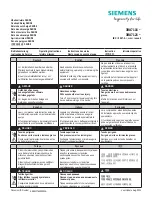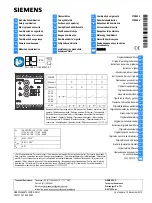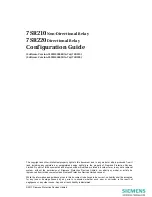
The AC-83 wireless output relay module
1 / 2
MJT51403
The AC-83 wireless relay output module
The AC-83 is a component of Jablotron’s Oasis system. It provides 3
relays which can be controlled by radio signals. The AC-83 is mains-
powered. The device is suitable for heating control via signals received
from wireless thermostats of the TP-8x series. You can use the device
in the following combinations:
o
With PGX and PGY outputs of a JA-8x control panel equipped
with a radio module (for switching between heating modes).
o
With RC-8x remote controls (for switching between heating
modes).
o
With JA-80M or JA-82M magnetic door-detectors (for heating
enablement or disablement).
1
2
3
4
R
A
D
IO
m
ax
F
5
A
/ 2
50
V
buttons
LEDs
fuse
max 5 A
X
Y
holes to route
a fixing belt
Installation
Installation of this module shall only be undertaken by
technicians holding a certificate issued by an authorized
distributor.
Warning: this device is galvanically connected to the
mains.
Open the module’s cover (1 screw) and take out the circuit board (2
tabs). Install the back part of the housing to the desired place, re-install
the circuit board, connect the wires and enroll the desired wireless
devices.
Terminals
L, N, N
Power 230V/50Hz (N, N is a pair of connected terminals)
Lp
Normally open contact for the Z common relay
L1
Normally open contact for the X output relay
L2
Normally open contact for the Y output relay
All normally open contacts are fused by a common 5 Amp fuse –
the total combined consumption of the terminals must not exceed
this limit.
Warning: The mains power output does not
provide mains isolation for safety!!
Function description
The
X and Y relays
are totally independent. Jablotron TP-8x
wireless thermostats can be enrolled to them individually using the X
and Y enrollment buttons. In parallel to thermostats, either
remote
controls
or a
JA-80 control panel
can be enrolled (however, these
devices cannot be used in a simultaneous combination) to control
switching the thermostat modes. In addition to the previously
mentioned, wireless magnetic door-detectors can be enrolled and
subsequently used to control the disabling of the heating.
The
Z relay
is designed to control a heating circulation pump. It
reacts to the logical OR sum of the X and Y relays – the Z output is
closed if, and only if, at least one of the X or Y relays is closed.
All three relays are used in combination to provide “
pump cleaning
”.
This function is realized by the simultaneous activation of the X, Y and
Z relays for 6 minutes every 7
th
day. This is especially
useful in the
summer
, when the heating system is out of operation. By such
activations a reduction of sediments is achieved in the heating system
and in the pump in particular. The function is not optional – it cannot be
disabled.
Enrollment procedure
•
Up to 8 wireless devices (thermostats, magnetic door-detectors,
control panel, remote controls) can be enrolled to each X or Y relay.
•
Use the
X or Y button
depending on which relay you want to enroll
a device to.
•
Enter
enrollment mode
(this is indicated by red LED No. 2 or 4
flashing) by pressing the button.
Use a safe insulation tool for button handling.
•
Activate the device’s transmitter
while the LED is flashing, as
follows:
o
Thermostat
(should be enrolled first) – connect its battery up (if
it has already been connected, first disconnect it, and then wait
10 seconds).
o
Control panel PG output
– key in 299 in service mode.
o
Key fob
– press a button.
o
Magnetic door-detector
– connect its battery up (if it has
already been connected, first disconnect it, and then wait 10
seconds).
•
Enrollment is confirmed
by a short flash from all AC-83 indicators.
•
If
no enrollment signal has been received within 10 sec.,
enrollment mode automatically ends.
•
If you wish to enroll
another device
, repeat the above enrollment
procedure.
Notes:
•
An overview of applicable control devices is provided in the table
below together with their enrollment methods and basic
descriptions of use.
•
If a device does not enroll, either it is too far from the receiver, or
too close, or the maximum number of devices (= 8) has been
exceeded.
•
Each transmitting device (keyfob, detector, control panel, etc.) can
be enrolled to an unlimited number of different receivers.
•
Devices are enrolled to a non-volatile memory, so the AC-83 will
not forget them if its power is disconnected.
Control
device
Enrolled by
Notes
PGx output
on the
control
panel
Keying in
299 in
Service
mode
switching between heating modes (anti-
freeze / temperature regulation)
- cannot be used in combination with
remote controls
Remote
control
Pressing any
button
switching between heating modes (anti-
freeze / temperature regulation)
- cannot be used in combination with a
control panel
Magnetic
door-
detector
Inserting a
battery
sensor activation (door or window
opening) disables standard temperature
regulation mode
- cannot be used in combination with
remote controls
Use with TP-8x thermostats
•
If a single thermostat is enrolled to a relay without any other
devices enrolled in parallel, the relay will switch the heating on or
off, according to signals from the thermostat.
•
If multiple thermostats are enrolled, the corresponding relay
switches on if at least one of the thermostats requires the heating to
be switched on.
•
The enrollment of a thermostat to a relay is indicated by green LED
1 for relay X and green LED 3 for relay Y.
•
Heating activation is indicated by red LED 2 for relay X and red
LED 4 for relay Y.
•
Other devices can be combined
with a thermostat and all be
enrolled to the same relay (a total of 8 devices, including the
thermostat).




















